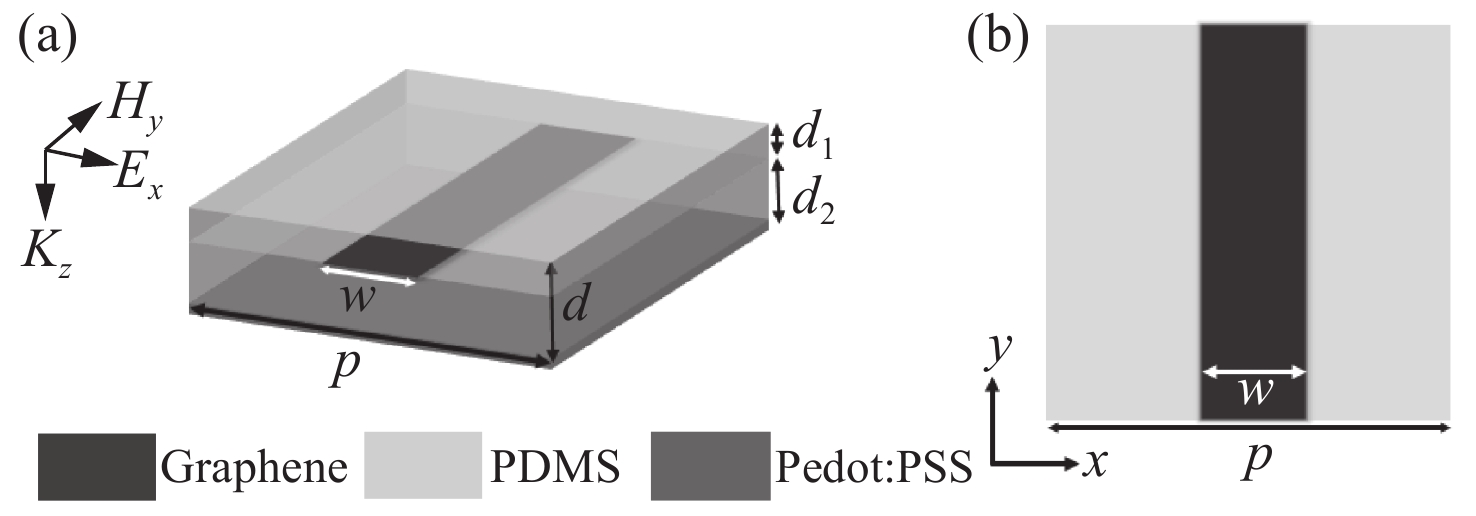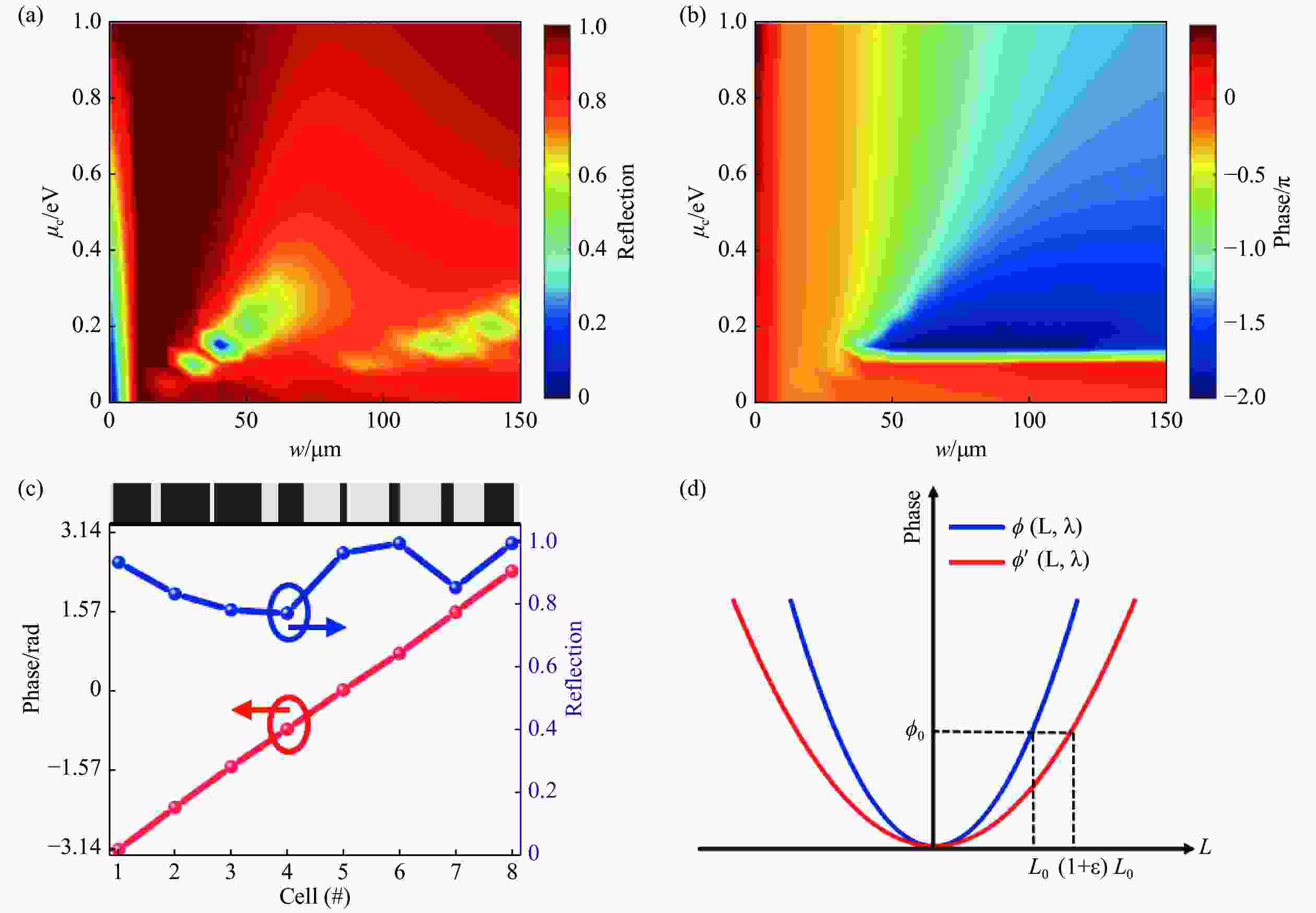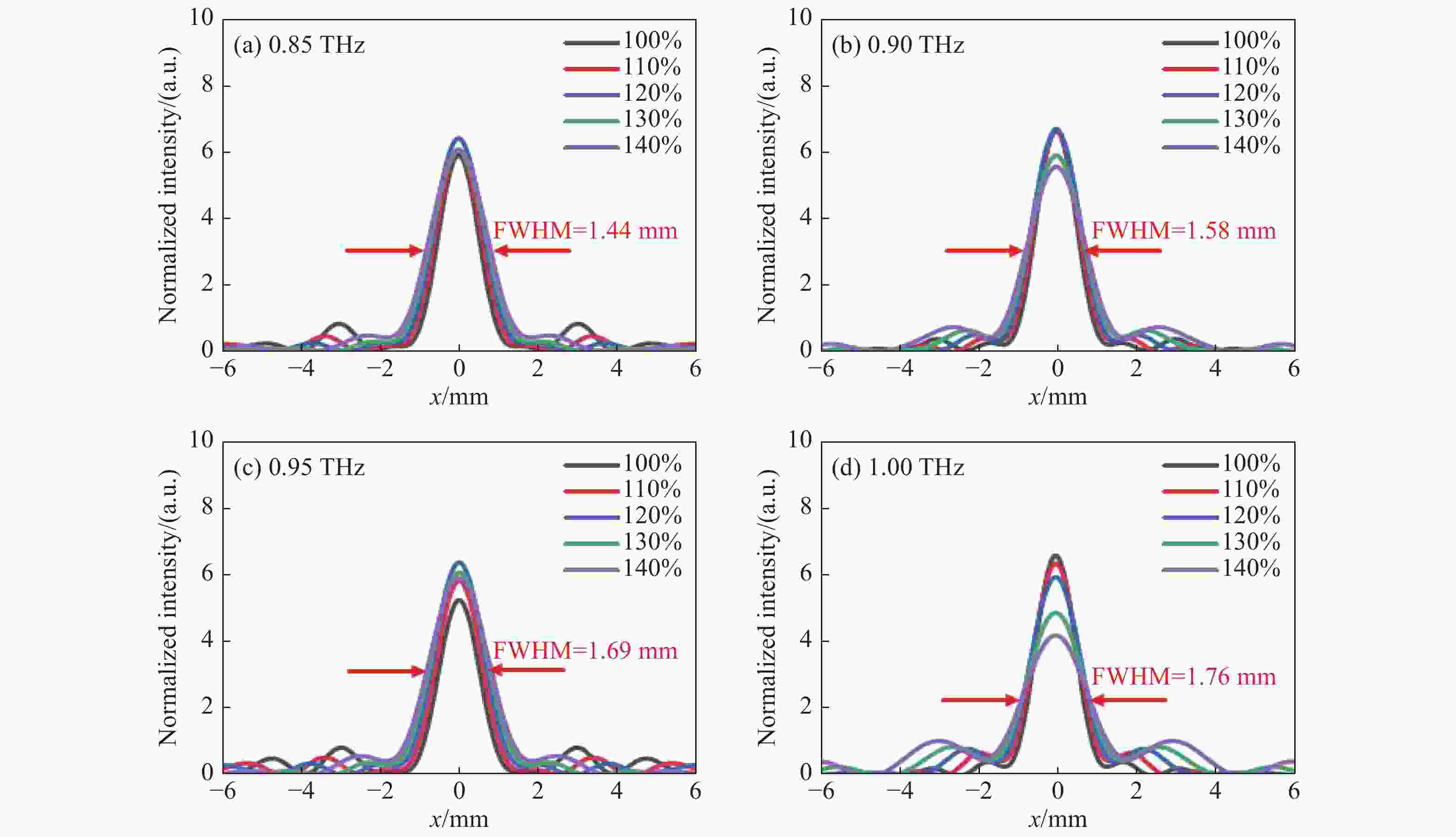Simulation on tunable graphene metasurface focusing mirror based on flexible substrate
-
摘要: 焦距范围可调的超薄聚焦反射镜在片上太赫兹光谱和成像等紧凑型系统中有重要应用价值。通过改变几何尺寸和调节化学势可以使石墨烯亚波长反射结构获得0~2π的相位,结合聚二甲基硅氧烷(PDMS)柔性基底的动态拉伸可以实现大动态范围的超薄太赫兹聚焦反射镜。本文设计了一个工作频率为1.0 THz,宽度为12 mm,焦距为60 mm,厚度为75 μm的柔性基底动态调焦石墨烯超表面聚焦反射镜。首先在基底自然状态下通过掺杂调节单元石墨烯条的化学势和改变宽度使其反射相位覆盖0~2π相位,并按照预定设计的相位空间分布达到反射聚焦效果。然后通过横向拉伸柔性基底实现反射镜焦距的动态调节。仿真结果表明:柔性基底长度在100%~140%内范围变化时,反射镜的焦距由53.4 mm增加到112.1 mm,动态调焦范围可达到最小焦距的109.7%,同时聚焦效率从69.7%减小到46.8%。此外,本文还研究了该反射镜在宽频带范围的工作性能。仿真结果表明:其对于在0.85~1.0 THz范围内的入射平面波都能实现良好的动态聚焦。Abstract: Ultra-thin focusing mirror with adjustable focal length has important applications in compact systems, especially for on-chip terahertz spectroscopy, imaging systems and communication systems. By changing the geometric size and adjusting the chemical potential, the graphene subwavelength reflective structure can achieve a phase of 0~2π. Combined with the above properties and the dynamic stretching of polydimethylsiloxane (PDMS) flexible substrate, the ultra-thin terahertz focusing reflector with large dynamic adjustment range can be realized. In this paper, a dynamic focusing graphene metasurface focusing reflector based on flexible substrate with a working frequency of 1.0 THz, a width of 12 mm, a focal length of 60 mm and a thickness of 75 μm is designed and investigated. Firstly, by adjusting the chemical potential and width of the graphene unit strips, the reflective phase covers the 0~2π, and the reflective focusing effect can be achieved according to the predesigned phase spatial distribution. Then, the dynamic adjustment of the focal length of the reflective mirror can be realized by laterally stretching the flexible substrate. The simulation results demonstrate that when the length of the flexible substrate varies from 100% to 140%, the focal length of the reflective mirror increases from 53.4 mm to 112.1 mm, the dynamic focus range can reach 109.7% of the minimum focal length, and the focus efficiency decreases from 69.7% to 46.8%. In addition, the performance of the reflective mirror in a wide frequency range has also been investigated, and the simulation results demonstrate that the good dynamic focusing for incident plane waves in the frequency range of 0.85~1.0 THz can be achieved. The proposed tunable metasurface design is highly versatile in the development of ultra-thin, multifunctional and tunable terahertz devices for various applications.
-
Key words:
- terahertz /
- graphene /
- meta-surface /
- flexible substrate /
- dynamic focusing
-
图 2 柔性基底动态调焦石墨烯太赫兹超表面聚焦反射镜工作示意图。(a)为拉伸前反射镜,衬底横向长度为L,基底厚度为d,焦距为f;(b)为衬底PDMS沿x轴拉伸ε后反射镜,横向长度变为L(1+ε),基底厚度为d/(1+ε),焦距
$f' $ 变为(1+ε)2fFigure 2. Schematic of the dynamic focusing graphene terahertz metasurface focusing on a flexible substrate. (a) is the encapsulated in a flexible polymer, the lateral length of the substrate is L, the thickness of the base is d, and the focal length is f; (b) is the reflector after the substrate PDMS stretches ε along the x axis, the lateral length becomes L(1+ε), the substrate thickness is d/(1+ε), and the focal length
$f' $ becomes (1+ε)2f图 3 柔性基底动态调焦石墨烯太赫兹超表面单元结构设计。(a)和(b)是单元结构的反射系数和相位随石墨烯的化学势μc和宽度w变化情况;(c)为经过优化计算得到的8个单元结构的反射系数和相位响应;(d)为拉伸前后PDMS衬底横向距原点距离与相位关系图
Figure 3. The design of graphene terahertz metasurface unit structure for dynamic focusing on flexible substrate. (a) and (b) is the change of the reflection coefficient and phase of the unit structure with the chemical potential μc and width w of graphene; (c) is the reflection coefficient and phase response of the eight unit structure obtained through optimization calculation; (d) is a diagram of the relationship between the PDMS substrate lateral distance from the origin and the phase before and after stretching
图 4 柔性基底动态调焦石墨烯太赫兹超表面聚焦反射镜在入射波频率为1.0 THz,衬底拉伸时归一化的电场分布。其中(a)~(e)对应衬底拉伸100%~140%
Figure 4. The normalized electric field distribution of the dynamic focusing graphene terahertz metasurface focusing mirror on the flexible substrate when the incident wave frequency is 1.0 THz and the substrate is stretched. (a)~(e) correspond to 100%~140% of the substrate stretch
图 5 柔性基底动态调焦石墨烯太赫兹超表面聚焦反射镜入射波频率为1.0 THz,衬底拉伸时理论焦距(黑色圆圈)与仿真计算焦距(红色方块)对比情况
Figure 5. The theoretical focal length (black circle) given by formula (4) when the substrate is stretched is compared with the simulated focal length (red square). The frequency of the incident wave of the dynamic focusing graphene terahertz metasurface focusing mirror on the flexible substrate is 1.0 THz
图 6 柔性基底动态调焦石墨烯太赫兹超表面聚焦反射镜在0.85~1.0 THz宽频工作频率下,PDMS拉伸幅度为100%到140%时,沿z轴(x=0)的电场强度分布图。其中(a)~(d)对应频率为0.85 THz、0.90 THz、0.95 THz和1.0 THz
Figure 6. The electric field intensity distribution of the graphene terahertz meta-surface focusing mirror with flexible substrate dynamic focusing along the z-axis (x=0) at 0.85~1.0 THz broadband operating frequency when the PDMS stretching range is 100% to 140%. Among them (a)~(d) correspond to frequencies 0.85 THz, 0.90 THz, 0.95 THz and 1.0 THz, respectively
图 7 柔性基底动态调焦石墨烯太赫兹超表面聚焦反射镜在0.85~1.0 THz宽频工作频率内,PDMS拉伸幅度为100%~140%的焦平面的电场强度分布图。其中(a)~(d)对应频率为0.85 THz、0.90 THz、0.95 THz、1.0 THz。
Figure 7. The electric field intensiy distributiton of the focal plane of the graphene terahertz meta-surface focusing mirror with flexible substrate dynamic focusing at 0.85~1.0 THz broadband operating frequency when the PDMS stretching range is 100%~140%. (a)~(d) correspond to frequencies of 0.85 THz, 0.90 THz, 0.95 THz, 1.0 THz.
图 8 石墨烯太赫兹超表面聚焦反射镜在0.85~1.0 THz宽频工作频率下的焦点位置(a, b)和聚焦效率(c, d)随柔性基底伸长100%~140%变化情况
Figure 8. The focus position (a, b) and focusing efficiency (c, d) of the graphene terahertz meta-surface focusing mirror at 0.85~1.0 THz broadband operating frequency varying with the elongation of the flexible substrate in the range of 100%~140%
表 1 柔性基底动态调焦石墨烯太赫兹超表面单元结构参数设计结果
Table 1. The design results of structural parameters of graphene terahertz metasurface units for dynamic focusing on flexible substrates
Cell(#) 







Parameter w=110 μm
uc = 1.00 eVw=140 μm
uc = 0.35 eVw=135 μm
uc = 0.14 eVw=75 μm
uc = 0.13 eVw=20 μm
uc = 0.03 eVw=37 μm
uc = 0.30 eVw=40 μm
uc = 0.45 eVw=85 μm
uc = 0.30 eVPhase(rad) −3.14 −2.31 −1.50 −0.76 0.02 0.74 1.56 2.37 Reflection 0.93 0.83 0.78 0.77 0.96 0.99 0.85 0.99 -
[1] MANJAPPA M, SINGH R. Materials for terahertz optical science and technology[J]. Advanced Optical Materials, 2020, 8(3): 1901984. doi: 10.1002/adom.201901984 [2] HE J W, DONG T, CHI B H, et al. Metasurfaces for terahertz wavefront modulation: a review[J]. Journal of Infrared,Millimeter,and Terahertz Waves, 2020, 41(6): 607-631. doi: 10.1007/s10762-020-00677-3 [3] ARBABI E, ARBABI A, KAMALI S M, et al. MEMS-tunable dielectric metasurface lens[J]. Nature Communications, 2018, 9(1): 812. doi: 10.1038/s41467-018-03155-6 [4] YU N F, GENEVET P, KATS M A, et al. Light propagation with phase discontinuities: generalized laws of reflection and refraction[J]. Science, 2011, 334(6054): 333-337. doi: 10.1126/science.1210713 [5] 林雨, 蒋春萍. 可调谐超构透镜的发展现状[J]. 中国光学,2020,13(1):43-61. doi: 10.3788/co.20201301.0043LIN Y, JIANG CH P. Recent progress in tunable metalenses[J]. Chinese Optics, 2020, 13(1): 43-61. (in Chinese) doi: 10.3788/co.20201301.0043 [6] SHERROTT M C, HON P W C, FOUNTAINE K T, et al. Experimental demonstration of > 230 phase modulation in gate-tunable graphene–gold reconfigurable mid-infrared metasurfaces[J]. Nano Letters, 2017, 17(5): 3027-3034. doi: 10.1021/acs.nanolett.7b00359 [7] BELOTELOV V I, KREILKAMP L E, AKIMOV I A, et al. Plasmon-mediated magneto-optical transparency[J]. Nature Communications, 2013, 4: 2128. doi: 10.1038/ncomms3128 [8] LI L L, CUI T J, JI W, et al. Electromagnetic reprogrammable coding-metasurface holograms[J]. Nature Communications, 2017, 8(1): 197. doi: 10.1038/s41467-017-00164-9 [9] LIU P X, ZHAO Y, QIN R X, et al. Photochemical route for synthesizing atomically dispersed palladium catalysts[J]. Science, 2016, 352(6287): 797-800. doi: 10.1126/science.aaf5251 [10] KOCH U, HOESSBACHER C, EMBORAS A, et al. Optical memristive switches[J]. Journal of Electroceramics, 2017, 39(1-4): 239-250. doi: 10.1007/s10832-017-0072-3 [11] WANG K H, LI J SH, YAO J Q. Sensitive terahertz free space modulator using CsPbBr3 perovskite quantum dots–embedded metamaterial[J]. Journal of Infrared,Millimeter,and Terahertz Waves, 2020, 41(5): 557-567. doi: 10.1007/s10762-020-00680-8 [12] WANG Y, CUI Z J, ZHU D Y, et al. Tailoring terahertz surface plasmon wave through free-standing multi-walled carbon nanotubes metasurface[J]. Optics Express, 2018, 26(12): 15343-15352. doi: 10.1364/OE.26.015343 [13] HE J W, XIE ZH W, SUN W F, et al. Terahertz tunable metasurface lens based on vanadium dioxide phase transition[J]. Plasmonics, 2016, 11(5): 1285-1290. doi: 10.1007/s11468-015-0173-2 [14] GUO J Y, WANG T, ZHAO H, et al. Reconfigurable terahertz metasurface pure phase holograms[J]. Advanced Optical Materials, 2019, 7(10): 1801696. doi: 10.1002/adom.201801696 [15] LI SH Q, XU X W, VEETIL R M, et al. Phase-only transmissive spatial light modulator based on tunable dielectric metasurface[J]. Science, 2019, 364(6445): 1087-1090. doi: 10.1126/science.aaw6747 [16] SHE A L, ZHANG SH Y, SHIAN S, et al. Adaptive metalenses with simultaneous electrical control of focal length, astigmatism, and shift[J]. Science Advances, 2018, 4(2): eaap9957. doi: 10.1126/sciadv.aap9957 [17] ZHU W M, SONG Q H, YAN L B, et al. A flat lens with tunable phase gradient by using random access reconfigurable metamaterial[J]. Advanced Materials, 2015, 27(32): 4739-4743. doi: 10.1002/adma.201501943 [18] BEHROOZINIA S, RAJABALIPANAH H, ABDOLALI A. Real-time terahertz wave channeling via multifunctional metagratings: a sparse array of all-graphene scatterers[J]. Optics Letters, 2020, 45(4): 795-798. doi: 10.1364/OL.383001 [19] FAN Y CH, SHEN N H, ZHANG F L, et al. Photoexcited graphene metasurfaces: significantly enhanced and tunable magnetic resonances[J]. ACS Photonics, 2018, 5(4): 1612-1618. doi: 10.1021/acsphotonics.8b00057 [20] HUANG Y C, LIN M F, CHANG C P. Landau levels and magneto-optical properties of graphene ribbons[J]. Journal of Applied Physics, 2008, 103(7): 073709. doi: 10.1063/1.2902455 [21] DING P, LI Y, SHAO L, et al. Graphene aperture-based metalens for dynamic focusing of terahertz waves[J]. Optics Express, 2018, 26(21): 28038-28050. doi: 10.1364/OE.26.028038 [22] HUANG Z G, HU B, LIU W G, et al. Dynamical tuning of terahertz meta-lens assisted by graphene[J]. Journal of the Optical Society of America B, 2017, 34(9): 1848-1854. doi: 10.1364/JOSAB.34.001848 [23] CHEN D B, YANG J B, HUANG J, et al. The novel graphene metasurfaces based on split-ring resonators for tunable polarization switching and beam steering at terahertz frequencies[J]. Carbon, 2019, 154: 350-356. doi: 10.1016/j.carbon.2019.08.020 [24] YIN ZH P, ZHENG Q, WANG K Y, et al. Tunable dual-band terahertz metalens based on stacked graphene metasurfaces[J]. Optics Communications, 2018, 429: 41-45. doi: 10.1016/j.optcom.2018.07.084 [25] ZHANG Z, YAN X, LIANG L J, et al. The novel hybrid metal-graphene metasurfaces for broadband focusing and beam-steering in farfield at the terahertz frequencies[J]. Carbon, 2018, 132: 529-538. doi: 10.1016/j.carbon.2018.02.095 [26] HAN S J, KIM S, KIM S, et al. Complete complex amplitude modulation with electronically tunable graphene plasmonic metamolecules[J]. ACS Nano, 2020, 14(1): 1166-1175. doi: 10.1021/acsnano.9b09277 [27] KAMALI S M, ARBABI E, ARBABI A, et al. Highly tunable elastic dielectric metasurface lenses[J]. Laser &Photonics Reviews, 2016, 10(6): 1002-1008. [28] CALLEWAERT F, VELEV V, JIANG SH ZH, et al. Inverse-designed stretchable metalens with tunable focal distance[J]. Applied Physics Letters, 2018, 112(9): 091102. doi: 10.1063/1.5017719 [29] 杨渤, 程化, 陈树琪, 等. 基于傅里叶分析的超表面多维光场调控[J]. 光学学报,2019,39(1):86-104.YANG B, CHENG H, CHEN SH Q, et al. Multi-dimensional manipulation of optical field by metasurfaces based on Fourier analysis[J]. Acta Optica Sinica, 2019, 39(1): 86-104. (in Chinese) [30] CHEN M K, WU Y, FENG L, et al. Principles, Functions and Applications of Optical Meta-lens[J]. Advanced Optical Materials, 2021, 9(4): 2001414. [31] 都妍, 武亚君, 张元, 等. 基于导电聚合物的太赫兹频率选择表面[J]. 太赫兹科学与电子信息学报,2019,17(2):205-208. doi: 10.11805/TKYDA201902.0205DU Y, WU Y J, ZHANG Y, et al. Terahertz frequency selective surface based on DMSO-doped PEDOT: PSS films[J]. Journal of Terahertz Science and Electronic Information Technology, 2019, 17(2): 205-208. (in Chinese) doi: 10.11805/TKYDA201902.0205 [32] PANCHAKARLA L S, SUBRAHMANYAM K S, SAHA S K, et al. Synthesis, structure, and properties of boron- and nitrogen- doped graphene[J]. Advanced Materials, 2009, 21(46): 4726-4730. [33] WEI D CH, LIU Y Q, WANG Y, et al. Synthesis of N-doped graphene by chemical vapor deposition and its electrical properties[J]. Nano Letters, 2009, 9(5): 1752-1758. doi: 10.1021/nl803279t [34] GUO B D, FANG L, ZHANG B H, et al. Graphene doping: a review[J]. Insciences Journal, 2011, 1(2): 80-89. [35] CHHIKARA M, GAPONENKO I, PARUCH P, et al. Effect of uniaxial strain on the optical Drude scattering in graphene[J]. 2D Materials, 2017, 4(2): 025081. doi: 10.1088/2053-1583/aa6c10 [36] YU N F, CAPASSO F. Flat optics with designer metasurfaces[J]. Nature Materials, 2014, 13(2): 139-150. doi: 10.1038/nmat3839 [37] ARBABI A, HORIE Y, BALL A J, et al. Subwavelength-thick lenses with high numerical apertures and large efficiency based on high-contrast transmitarrays[J]. Nature Communications, 2015, 6(1): 7069. doi: 10.1038/ncomms8069 -






 下载:
下载:











